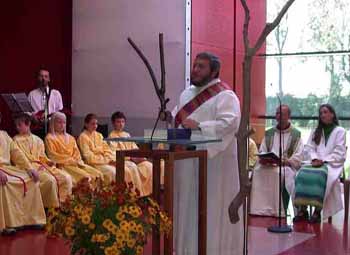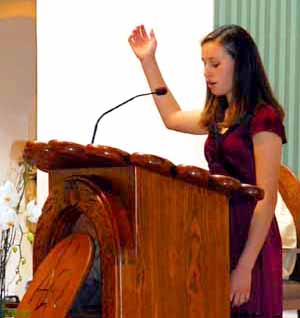 |
A Column of Catholic Orientation
The Feminization of the Church
and Vatican II
Marian T. Horvat, Ph.D.
There has been much talk of late about a long-observable fact: the feminization of the Catholic Church. My friend Jan was quite impressed with the term and thought it accurately expressed the reality.
“I went to a Catholic church downtown yesterday,” she said, “and really, it was all women on the altar – except for the priest. At Communion four ladies – three in pants –went to the side altar to pick up the chalices. The song leader was sensuous, in a blouse showing cleavage, waving her arms like a traffic cop. Only a few women in the pews were singing along. All the altar boys were girls.”

The Mass service invaded by women and girls in Linz, Austria |
According to the National Pastoral Life Center (NPLC), today there are more lay ministers than priests working in Catholic parishes: that is, 31,000 lay ministers to 29,000 diocesan priests. It notes that this “revolution in ministry” has meant a “stronger lay, feminine dimension” in the Church. (1)
Quite correctly stated. Almost every parish across the country uses scores of lay eucharistic and song ministers, lectors, and altar servers for its various Masses. Then, there are the liturgists, youth ministers, social concerns directors, adult education coordinators and other professional pastoral positions that never existed before Vatican II. Lay ministers make most of the pastoral visits to the sick and prisoners. And roughly 80 % of these positions are held by women. The NPLC predicts that the overall pattern indicates the bulk of positions will continue to be filled by women. (2)
Parishes have become “feminized,” the NPLC report continues, not only because many lay ministers are women, but also because parish ministry has become more collaborative and concerned with nurturing. This “feminine” spirit is to replace, I suppose, a “masculine” spirit which is more akin with hierarchy and institution.
In short, today’s parish minister is more likely to be a layperson – and a woman. And increasingly, women are on the altar doing almost everything – including preaching.
The easily discerned cause
To understand the cause for this feminization, Jan decided to read a book on the topic by the reportedly conservative Catholic Leon J. Podles entitled The Church Impotent: The Feminization of Christianity. But, she reported to me, the book didn’t seem to really explain how things had changed so radically in so short a time. She asked my opinion.
Podles identifies the problem: an altar overrun by women, songs written to please a woman’s sentiments (“You are my everything,” etc.), an ethos of pacifism and self-surrender, all of which serves to render the men who still frequent the churches passive and emasculated.

A young woman in a sweat shirt distributes Communion without seriousness. Below, a woman-cantor directs the singing at the Mass
 |
But he doesn’t even get close to the nail when he tries to hit the cause for the calamity.
Quite extravagantly Podles places the principal responsibility for this process of feminization on St. Bernard of Clairvaux, the rise of scholasticism and the expansion of female monasticism. His rationale for such fantastic claims is simply too complicated to enter into here. There is convoluted twisting and turning through Platonic influences and Aristotelian dichotomies.
In the end he never finds the simple solution to the present-day astonishing crisis of the feminization of the Catholic Church. He fails to see the obvious, that this process is a direct consequence of Vatican Council II.
In the United States today, 45 years after Vatican II, 31,000 lay persons plan liturgies, direct the music groups, schedule the lectors and run the education programs for adults, engaged couples and children; four-fifths of these ecclesial ministers are women. Before Vatican II, most of those jobs did not exist; less than 1 % of these jobs were filled by lay people. (3) Before Vatican II the average parish lay woman were most likely to be found in the Altar Society or Holy Name Society. Today, almost 50 % of all administrative positions in dioceses are held by women.
Before Vatican Council II, Catholic men frequented the Sacraments, took family responsibilities seriously and filled the seminaries. After Vatican Council II, the churches emptied, the divorce rate skyrocketed, and the sacristy was overrun with women. A kind of effeminate man attracted by the New Theology entered the seminaries, and the virile ethos of the Church grew fainter and fainter. It is no wonder not only men, but also many women, are leaving the Catholic Church today or no longer assist at Sunday Mass.
Vatican II opened the doors to a lay, feminine church
At the 40-year anniversary of the closing of Vatican II, a spate of analysis of the Council’s fruit flooded the Catholic press. I do not know of a single one that failed to underscore the new lay ministry as one of the significant marks of the Council’s legacy. Of course, that lay component is mostly women.

John Paul II posing with altar girls |
Ministry transformation as part of the Church renewal is based in particular on the teachings of Lumen Gentium, the Constitution on the Church, which encourages the layperson’s active participation in the liturgy. It also presents the Catholic Church as a communion of baptized believers with a call to ministry, which sounds an awful lot to me like the heretical Protestant statement that “every man is a priest.”
The result has been the multiplication of lay ministries, with lay men and women replacing clerics in numerous church positions.
It is clear to the objective onlooker these three things are necessarily enchained:
- The Clergy is increasingly less numerous and more absent;
- Lay people are ever more present and taking over clerical tasks;
- Women are taking over the majority of the lay ecclesiastical jobs.
No sign of change
I wish I could tell my friend Jan that I see positive signs of a less femininized Church in the future. But I can’t.

Women and girls in the liturgy during Benedict XVI's visit to Bavaria |
Pope Benedict XVI made it clear from the first day of his election that Vatican II will be the “compass” of his papacy. The compass, of course sets direction. (4) With regard to women and lay ministries, all his actions indicate he will continue the effort to empower women in the Church in all ways short of sacramental ordination.
By the end of John Paul II’s pontificate, women were 21 % of Vatican personnel. (5) Benedict XVI has stated that he would like “to offer more space, more positions of responsibility to women” and affirmed that he would consider opening more influential Church positions to women. (6) Following JPII’s model, he speaks often of the human dignity of the person, decries every kind of “discrimination” against women, and proclaims the need for equality of opportunity in the public sphere.
Among the Bishops, one finds this same concern to increase women’s visibility in the Church. Here is one recent example. At the February 2008 Bishops Conference in India, the Prelates made “women’s empowerment in the church and society” a high item on the agenda to correct the problem of women’s under-representation in administrative and executives roles in the Church. They voted to set quotas, requiring that at least 35 % of members and office bearers in parish and diocesan pastoral councils should be women. The quota will grow gradually until women get at least 50% of positions. (7)
The position of resistance Catholics should adopt is more than a mere “nostalgia” for the old ways of worship. We have an obligation to resist this feminization of the Holy Church.
1. National Pastoral Life Center. Lay and Religious Parish Ministry: A Study Conducted for the National Conference of Catholic Bishops, 1991
2. Ibid.
3. “Today’s parish minister more likely to be a layperson,” Catholic News Service, October 21,2005
4. “Forty years later, Vatican II continues to reverberate through the Church”, Catholic News Service, Oct. 12, 2005.
5. “Women chip Vatican’s glass ceiling with increased numbers, influence,” Catholic News Service, March 7. 2007
6. “Vatican Shows New Openness to Women,” National Catholic Reporter, November 3, 2006
7. “India’s Bishops strive for Gender Equality in Church Bodies,” National Catholic Reporter March 7, 2008.

Posted on May 13, 2008

Related Topics of Interest
 Ratzinger on Feminism Ratzinger on Feminism
 Is God Mother? Is God Mother?
 The Vatican's Feminism The Vatican's Feminism
 Women in Sports Women in Sports
 Papal Preacher: Wives Should Not Obey Husbands Papal Preacher: Wives Should Not Obey Husbands
 A Dutch Priestess in the Making A Dutch Priestess in the Making
 An Austrian Priestess An Austrian Priestess
 Women Priests - The Process Starts Women Priests - The Process Starts
 The Cathedral of Joliet's Acolytes The Cathedral of Joliet's Acolytes
 |
  |
Talks with Jan | Religious | Home | Books | CDs | Search | Contact Us | Donate

© 2002-
Tradition in Action, Inc. All Rights Reserved
|
 |
|